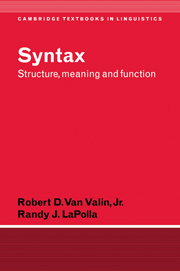Book contents
- Frontmatter
- Contents
- List of figures
- List of tables
- Acknowledgments
- Notes for instructors
- List of abbreviations
- 1 The goals of linguistic theory
- 2 Syntactic structure, I: simple clauses and noun phrases
- 3 Semantic representation, I: verbs and arguments
- 4 Semantic representation, II: macroroles, the lexicon and noun phrases
- 5 Information structure
- 6 Grammatical relations
- 7 Linking syntax and semantics in simple sentences
- 8 Syntactic structure, II: complex sentences and noun phrases
- 9 Linking syntax and semantics in complex sentences
- Epilog: the goals of linguistic theory revisited
- Notes
- References
- Index of languages
- Subject index
7 - Linking syntax and semantics in simple sentences
Published online by Cambridge University Press: 05 June 2012
- Frontmatter
- Contents
- List of figures
- List of tables
- Acknowledgments
- Notes for instructors
- List of abbreviations
- 1 The goals of linguistic theory
- 2 Syntactic structure, I: simple clauses and noun phrases
- 3 Semantic representation, I: verbs and arguments
- 4 Semantic representation, II: macroroles, the lexicon and noun phrases
- 5 Information structure
- 6 Grammatical relations
- 7 Linking syntax and semantics in simple sentences
- 8 Syntactic structure, II: complex sentences and noun phrases
- 9 Linking syntax and semantics in complex sentences
- Epilog: the goals of linguistic theory revisited
- Notes
- References
- Index of languages
- Subject index
Summary
Introduction
In this chapter we address the details of the linking between syntax and semantics in simple sentences, that is, between the semantic representations introduced in chapters 3 and 4 and the syntactic representations introduced in chapter 2. This will involve syntactic pivots and controllers, as discussed in chapter 6. This will also involve focus structure, as we saw at the end of chapter 5. The system for linking syntax and semantics developed in chapters 3–6 is summarized in figure 7.1. The selection of privileged syntactic arguments, i.e. syntactic pivots and controllers, is based on the actor part of the Actor–Undergoer Hierarchy, as given in (7.1).
(7.1) Privileged syntactic argument selection hierarchy
arg. of DO > 1st arg. of do′ > 1st arg. of pred′ (x, y) > 2nd arg. of pred′ (x, y) > arg. of pred′ (x)
In syntactically accusative constructions, the highest-ranking argument is the default choice to be the privileged syntactic argument (pivot or controller), whereas in syntactically ergative constructions, the lowest-ranking argument is the default choice. As we will see later in the chapter, languages vary as to whether the privileged syntactic argument must be a macrorole or not. PSA modulation voice constructions permit an alternative choice for pivot or controller. The basics of the linking for a simple sentence in English are illustrated in figure 7.2, repeated from chapter 5; the operator projection is omitted. The double-headed arrows in figures 7.1 and 7.2 indicate that the linking is bidirectional, that is, that linking goes from semantics to syntax and from syntax to semantics.
- Type
- Chapter
- Information
- SyntaxStructure, Meaning, and Function, pp. 317 - 440Publisher: Cambridge University PressPrint publication year: 1997

